Detoxing: Strengthening Your Body's Defense Team
/Detoxification is a natural healing process that incorporates resting, cleansing, and nourishing the body from the inside out. By eliminating toxins, then fueling your body with healthy nutrients, a planned period of detox can strengthen your body's natural "Detox Team" and help maintain optimum health.
Holistic physicians and proponents of detoxing suggest following a detox plan at least once per year, with spring and fall being the ideal approach. You may have heard critics argue the human body is designed with just the right physiological processes necessary to clear the body of impurities and maintain health. Unfortunately for many people, lifestyle habits and the environments where we live, work, eat and play often expose us to toxins that our bodies don't efficiently eliminate.
The toxins you can be exposed to everyday include:
- heavy metals in the food and water supply
- environmental pollution
- chemical food additives
- smoking; overuse of alcohol or drugs
- use/overuse of Rx medication
- prolonged high stress
- poor quality diet and lifestyle habits
- frequent colds or chronic illness
Your Body's Natural Detox Team
Your body naturally detoxifies itself via a Detox Team of organs that work synergistically to neutralize and eliminate toxins, with the goal of keeping the blood and cells free of impurities. The liver leads the Detox Team by processing toxins for elimination. The supporting detox defense players are the kidneys, intestines, lungs, lymph, and skin. When your body's natural Detox Team becomes compromised, impurities aren't properly filtered out. This makes it a real challenge for the Detox Team to maintain or restore health and well-being.
Detoxing Boosts Your Health
Following a detox program suited to your personal needs supports the body's natural cleansing process and boosts your health in many ways:
- Allows digestive organs to rest
- Stimulates the liver to process toxins more efficiently
- Promotes movement of bowels
- Improves circulation
- Enhances sweating, which facilitates release of impurities
- Restores vital nutrients and energy to the body
6 Things to Know Before You Detox
Before you begin a detox, prepare mentally and physically. Plan your dates a few weeks in advance. Inform the people closest to you about the time you've set aside to take care of yourself. Clear your schedule of routine obligations that may create stress. Stock up on inspirational music and reading material.
Gather Herbal Support. Herbal and nutritional supplements such as burdock, milk thistle, dandelion, and vitamins C and B protect and support the body's Detox Team, especially the liver. They also have antioxidant effects that benefit the whole body.
Hydrate! Without enough water, toxins will not be sufficiently flushed from the body. Aim to drink at least 2 quarts of water per day with lemon/lime during a detox.
Dry Brush Your Skin. Look for a brush with soft natural bristles. Begin with light, gentle brushing over the skin (don't make the skin red). Always brush towards the heart. Shower immediately after to rinse off exfoliated skin.
Get Wet. Therapeutic use of water also supports detoxification. A steam or sauna can accelerate the release of toxins. Hydrotherapy provides support to the muscles and promotes relaxation. Mineral bath salts also help release toxins.
Sweat it Out-Gently. Exercise facilitates digestion, circulation, metabolism and hormone balancing. During a detox, decrease the intensity of your usual exercise routine, but do break a moderate sweat. Get outdoors for fresh air and natural sunlight. Good exercise options are easy hiking, dancing, walking, yoga, or tai chi.
Rest. For your mind and body to fully assimilate the benefits of detoxing, you need good quality sleep. Plan your least stimulating activities (reading, meditation, bathing) for right before bed.
How to Detox?
There are many ways to approach detoxing, from fruit and vegetable juice fasts to herbal tea cleanses. There are people who must be under the care of a health practitioner, such as pregnant or nursing women or those diagnosed with certain conditions such as diabetes. In general, it's important to work with Dr. Bossio to select a program that matches your health needs.
Image Attribution: dolgachov/bigstockphoto.com
References





